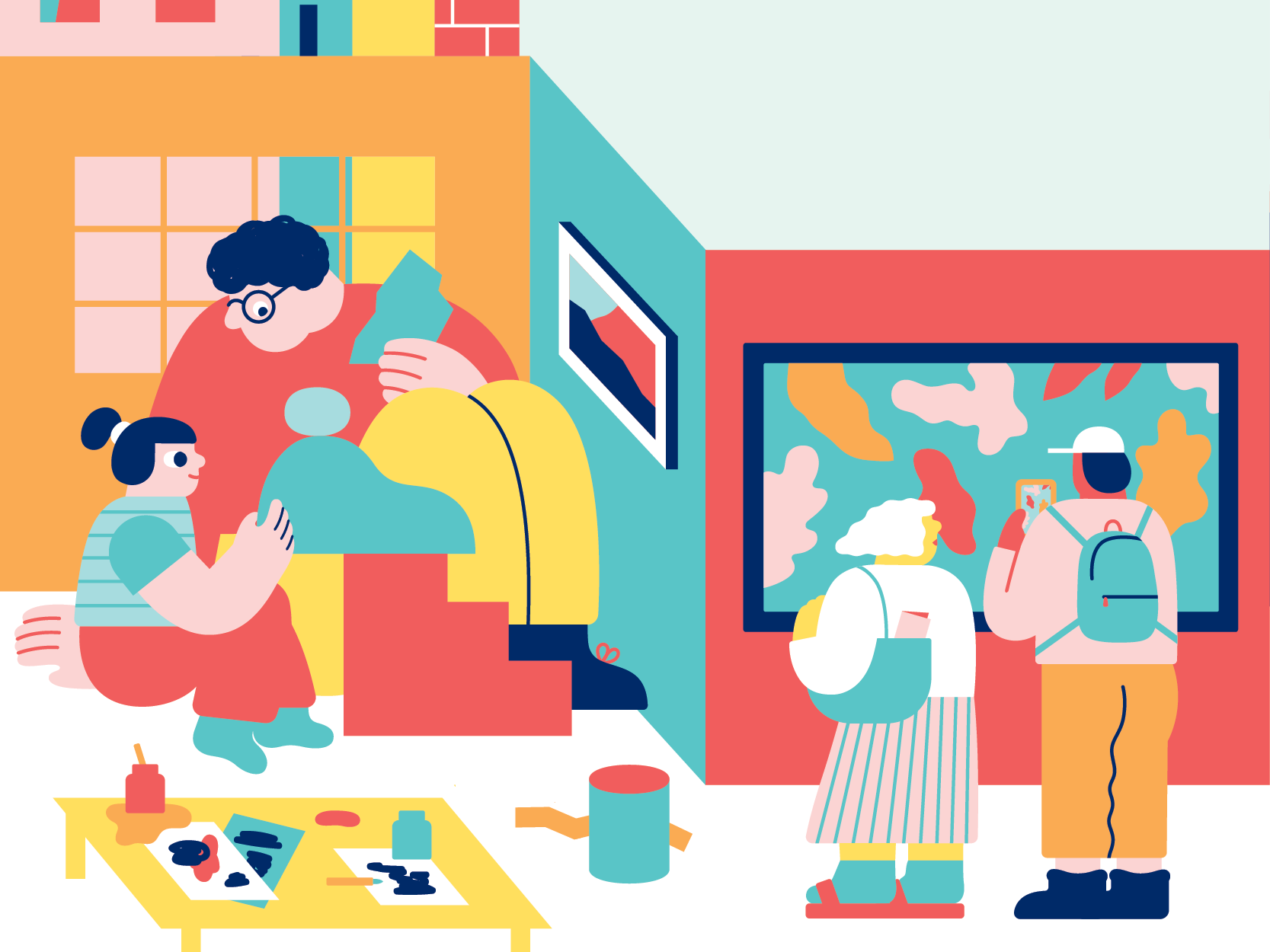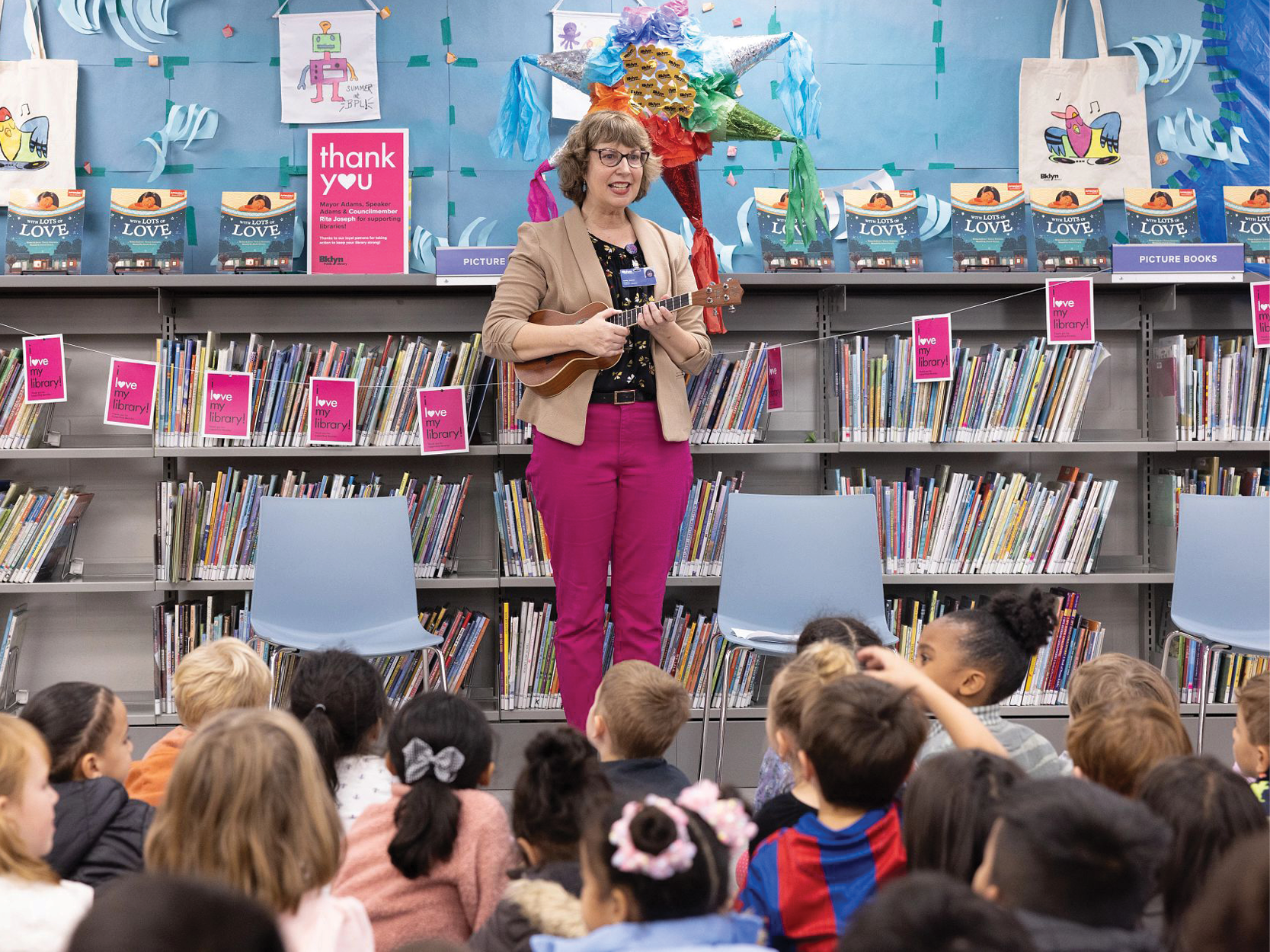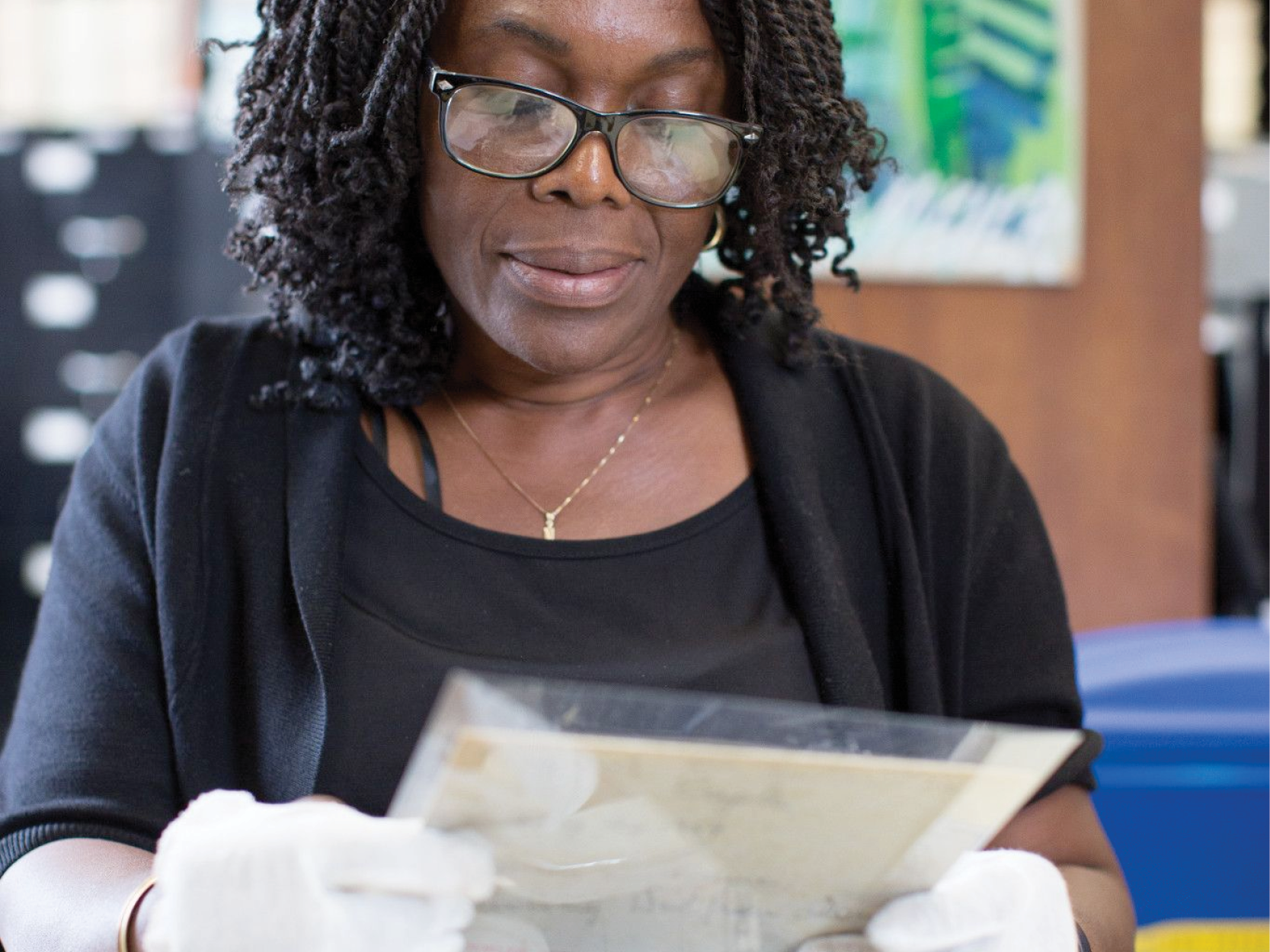It turns out that libraries weren’t always so friendly toward children. That started to change around the turn of the 20th century, thanks to a librarian who is pretty much unknown today. We're taking a field trip to a library truck in the Flatlands, a story time at Central, and to Brownsville in 1914...
Want to read more about the topics brought up in this episode? Check out the following links:
- Click here for a full list of book recommendations, curated for this episode, "For Kids' Sake."
- Learn about the past and present of the Brownsville Children's Library (now Stone Avenue) and Clara Whitehill Hunt.
- See the Kidsmobile in action or find programming for kids at your local library.
- Watch Lindsay's videos on Queer Kid Stuff.
- Listen to the Story Seeds podcast, coming from Literary Safari soon.
Click here for a full list of book recommendations, curated for this episode, "For Kids' Sake."
Episode Transcript
Irthan Ridore So, my name is Irthan Ridore and I’m 10 years old. My favorite book is Stuck in the Stone Age by Geoff Rodkey. It’s about an evil doctor and nobody but he’s actually using people as test subjects and they send them to different dimensions.
Jaeliana Jackson My name is Jaeliana and I’m seven years old. I like Pinkalicious. And I also like Pete the Cat.
Phoebe Neufeld Hi, I’m Phoebe. I’m 11 years old. I’m reading Pride and Prejudice by Jane Austen. It’s really complicated and really cool.
Felice Belle Irthan Ridore, Jaeliana Jackson and Phoebe Neufeld are three young Brooklyn library patrons. We met them at Central Library a few weeks ago, and as you could tell, they were eager to talk about their favorite books. Kids are a big part of the public library. It’s hard to imagine what the library would be without children.
Krissa Corbett Cavouras But it turns out that for a good long while, public libraries weren’t for kids at all.
Felice Belle That’s what we’re going to talk about today. I’m Felice Belle.
Krissa Corbett Cavouras And I’m Krissa Corbett Cavouras. You’re listening to Borrowed.
[ENGINE SOUND]
Felice Belle One wintery day in January, Clyde Kerlew and Freddie Rivera get into a truck.
Krissa Corbett Cavouras It snowed the night before. Clyde’s breath comes out in white puffs. Freddie does a five or maybe seven point turn out of the cramped parking lot in the Flatlands neighborhood of Brooklyn.
Clyde Kerlew We’re heading down Kings Highway. So this is a well-traveled route... kind of Rockaway Avenue at some point. We’ll be there in about 15 minutes, 20 minutes barring any tragedies or traffic problems, which we have encountered.
Felice Belle Almost every day Clyde and Freddie drive around Brooklyn. They have a comfortable relationship, and have been working together since 2002.
Clyde Kerlew If they see us driving by, they see the truck and they grab their parent’s arm and they point at the truck. That happens a lot. It's like, “Mommy look!”
Krissa Corbett Cavouras You might be thinking this is an ice cream truck. But it's not. This truck is a library.
Felice Belle I was waiting for that.
Krissa Corbett Cavouras We are a library podcast...
Felice Belle For a minute there, it sounded like we were going to do a story on trucking routes...
Krissa Corbett Cavouras Maybe next season! Here’s Clyde again.

(Brooklyn Postcard collection, Brooklyn Public Library, Brooklyn Collection)
Clyde Kerlew It’s a large van, about 10, 12 feet deep. Shelves on either side. Four on either side. About 2,500 to 3,000 paperbacks and a couple of hard covers.
Felice Belle The interior of this library truck, known as the Kidsmobile, is a magical wonderland. There are paper butterflies taped to the ceiling, thanks to Clyde’s crafting.
Clyde Kerlew I cut them up and put them around... different characters. Pinkalicious, I got Fancy Nancy, Captain Underpants. Originally the Kidsmobile was conceived to service hard to reach locations or places that people had unsafe intersections like the one we’re approaching right now. You know they don’t want to cross the streets with their classes or whatever.
Krissa Corbett Cavouras Because it’s sometimes hard to bring small children to the library, the library comes to them. After the Kidsmobile made its way to Crown Heights, Freddie pulls into a driveway across the street from a Daycare center.
Freddie Rivera We’ve done as much as 200 kids in a day. We do seven, eight classes.
Clyde Kerlew Early childhood we can squeeze in like 30 kids.
Felice Belle These toddlers, three and four year olds, are bundled up to their noses against the cold. They file in and find a space to sit in the Kidsmobile.
Clyde Kerlew Come on in, come on in. Knees together, hands folded like this. Elbows in.
Kid Hello.
Clyde Kerlew Hi.
Felice Belle Some are pointing at the pictures on the walls and ceilings, some are just staring at Clyde, who is a pretty big guy with an even bigger personality. He corrals the kids into order, encourages them, makes jokes, and even growls at them to get everyone to listen.
Clyde Kerlew All right! Who goes to the library?
Kid Me!
Clyde Kerlew Just one? Well you’re all in the library right now, so I tricked you! You all go to the library. Okay, what’s inside the library?
Kids Books!
Clyde Kerlew That's right, we have books in the library.
Krissa Corbett Cavouras Even though Clyde has been giving pretty much the same speech every day for the last sixteen years, it’s as if this is the first group of kids to ever come into the truck. He’s engaging and funny, and he walks them through what a library is.

program for kids. (Gregg Richards, Brooklyn Public Library)
Clyde Kerlew What’s this?
Kid Credit card!
Clyde Kerlew Mister … What did you say?
Kid Library card.
Clyde Kerlew Library card. Yes! This guy's got all the answers.
Krissa Corbett Cavouras Over the course of one year, this little library truck will serve as many as 14,000 children.
Felice Belle That’s a lot of kids!
Krissa Corbett Cavouras It is! And, every kid who visits the Kidsmobile can sign up for a library card or check out a book right off the shelves.
Clyde Kerlew … and you do it forever! As long as you have a library card.
Krissa Corbett Cavouras After Clyde does his speech about the library, it’s the moment the kids have all been waiting for.
Clyde Kerlew You ready for your book? This story is called Bark, George. "George’s mother said: Bark, George. George went: Meow."
Felice Belle If you’re a regular library patron chances are you’ve heard a few storytimes like this one in your visits to the library.
Krissa Corbett Cavouras Yeah, and even if you don’t have kids, you’ve probably heard in the library. Kids are a big part of libraries. Without them, libraries would be a lot quieter, but also probably a lot less exciting.
Felice Belle But libraries haven’t always embraced children like we do now. Back in the day, libraries were mostly for adults. Children were thought of as noisy and dirty and not to be trusted near books.
Krissa Corbett Cavouras Around the turn of the 20th century, that started to change. And Brooklyn was one of the pioneers of children’s librarianship. Felice, let’s go back in time.
Felice Belle Awesome, where are we going?
Krissa Corbett Cavouras We’re going to 1914. We're going to the corner of a block in the Brownsville neighborhood in Brooklyn. There’s a new building on this corner. It looks like a castle. There’s a line of children from the entrance of the building snaking all the way down the block. Each kid has a book in his or her hands. It might take a few hours until the children at the back of the line reach the front and finally enter the library. But it will be worth it. This scene comes to us from an archival photograph taken outside of the new Brownsville Children’s Library. We’ve put the picture up on our website so you can take a look.

(Brooklyn Public Library, Brooklyn Collection)
Felice Belle That photograph was taken in 1930, and it is really amazing because it shows just how popular this library was in the years after it first opened. Brownsville Children's Library was among the first dedicated library buildings for children in the country! By 1917, circulation at this branch reached 361,000 items in one year, from a collection of only 14,000 books.
Krissa Corbett Cavouras Brownsville was at the time made up of mostly newly arrived Jewish immigrants from Russia. The children were avid readers, and they were overwhelming the other branches. So, the Brownsville Children’s Library was built to address the problem of too many kids.
Felice Belle Today, that branch is still standing—it’s called Stone Avenue and it’s a library for all ages. You can go to the branch and see some of the original stonework and benches near the fireplace.

(Brooklyn Public Library, Brooklyn Collection)
Krissa Corbett Cavouras The original Brownsville Children’s Library was built thanks to a person who is pretty much unknown today. Clara Whitehill Hunt worked at Brooklyn Public Library from 1903 to 1939 as the Superintendent of Work with Children… which is quite a title.
Kimberly Grad She believed in establishing new traditions with working with children and was concerned about creating a cohort of children’s librarians who had the capability of catering just to children.
Felice Belle This is Kimberly Grad.
Kimberly Grad Kimberly Grad, I’m the Coordinator of School Age Services.
Felice Belle Kimberly started out as a children’s librarian and she did her thesis on Clara Whitehill Hunt’s impact on Brooklyn’s library system and her impact on children’s librarianship nationally.
Krissa Corbett Cavouras Hunt created training programs for young women to become children’s librarians. Which was amazing in a time when not many professions were open to women at all.
Felice Belle And Hunt made a point to ensure that new library branches had spaces specifically designed for kids.
Kimberly Grad So she thought about things like—making sure there was plenty of natural and artificial light. She wanted to make sure the windows were installed above the shelving which was five feet tall, and this was to prevent children from tossing books out the window. She wanted to make sure the reference desk was no higher than 36 inches so children could see over the desk and be seen.

Flatbush Library in the 1930s.
(Brooklyn Public Library, Brooklyn Collection)
Krissa Corbett Cavouras Just thinking about how one little detail—that the reference desk was lower in the children’s section, so kids could see over it and be seen. It just shows you how much Hunt considered the individuality of these kids.
Kimberly Grad And what I think is really fascinating is that we’re still doing that today, whenever we open up a new branch, the youth and family services department is consulted quite remarkably on all of the details that clara hunt considered.
Krissa Corbett Cavouras Hunt spent a lot of time thinking about the stories that children should be surrounded with. In 1915, she wrote a book called “What Shall We Read to the Children.”
Kimberly Grad And this is where she gave advice to parents about what they should select for their children. She wrote about how important it is to read to babies, and how we should be modeling for them. This was 1915, she was writing about some of the concerns we are still working on today.
Felice Belle She also had some strong words about children’s books she didn’t think were so great. She wrote in the Brooklyn Daily Eagle that “the child allowed to indulge in the cheap series habit becomes a sort of psychological dope fiend…”
Krissa Corbett Cavouras Yikes. So, no Captain Underpants for Clara Whitehill Hunt. Which is a great series, by the way!
Felice Belle Fortunately our book selection at Brooklyn has expanded beyond what Hunt thought was important in the 1930s. But she did do a lot of work to elevate the idea of children’s literature.
Krissa Corbett Cavouras Hunt made a point to collect historical children’s books to create a kind of archive. At the end of her time at Brooklyn Public Library, she donated about 13,000 children’s books from all over the world—some published as early as the 1700s. Her collection is still stored at Central Library, in a place called “The Treasure Room.”
Felice Belle The treasure room isn’t open to the public, but if you want to do research there, you can make a special request.
Krissa Corbett Cavouras And, Felice, it’s partly thanks to Clara Whitehill Hunt that we have an idea about what to read to kids and where. Kids can walk into pretty much any public library today and have a space to go that is made just for them.
Felice Belle It’s no small thing. The fact that kids are free to stumble into public libraries means they can encounter all kinds of ideas and people that they wouldn’t necessarily meet in their daily lives.
Lindsay Amer A song about consent… for the grownups, it’s a little relevant... [SINGING] “If someone asks if you want to play and you don’t want to, say no. It’s A-OK to say no…”
Felice Belle Take this story hour in Central Library.
Krissa Corbett Cavouras Lindsay, the host of Queer Kid Stuff, an LGBTQ+ educational web series for kids, drew a pretty good crowd one Saturday morning. Parents and their children packed onto the colorful rug to hear Lindsay sing songs and read progressive kids books.
Lindsay Amer "Everyone knows that no means no, but some other words mean no..." Here's where you guys are going to have to help me out. "Maybe means... NO! Perhaps tomororw means... NO!"
Felice Belle Maritsa, the mother of a five year old named Luca, came to Brooklyn’s Central library that day because she had seen information about Queer Kid Stuff on BPL’s website. Her child, Luca, had been talking about their own gender identity, which is what prompted Maritsa to look for programs that would help Luca feel comfortable.
Maritsa I think that the issue of gender is something that sometimes is not articulated as much in schools. And what I noted was that Luca doesn’t feel completely comfortable in open spaces like this particularly when he, when they doesn’t know people around. Recently he have shared... I mean, he say I’m not a he I’m a they. And we’re very proud of how this learning are helping they explore all the genders, but also at such a young age.
Felice Belle After the program, Lindsay, who uses they/them pronouns too, spoke about the problem of communicating progressive ideas in public spaces. When they first tried to perform shows that dealt with things like gender identity and sexual orientation in schools, they were met with pushback.
Lindsay Amer So I was like, okay, let's just get this happening and let's just make some YouTube videos, because kids are on Youtube, and I discovered that as this was happening.
Krissa Corbett Cavouras Lindsay’s videos are for kids ages three to eight and cover topics like gender identity, activism, and issues of consent. Things that kids might not be exposed to in other parts of their lives.
Felice Belle Lindsay talked about how great it is to have their series at the library.
Lindsay Amer The fact that this is a free event for anyone to come to and if they had stumbled on it on your webpage and just decided to come one day, that’s great. It’s very similar to YouTube in that way of like you can stumble on it and it’s there for you and this is kind of the live version of that.
Felice Belle That’s a pretty strong argument for making the library more like YouTube.
Krissa Corbett Cavouras From Clara Whitehill Hunt to the Kidsmobile to storytimes that are more like YouTube—it is all happening here.
Felice Belle Let’s let Lindsay sing us out.
Lindsay Amer [SINGING] "Horses with horns are called unicorns. Some other horses shout: NAY! Cuz unicorns stand out. But unicorns never fear when horses call them queer. Because queer means different and being different is so much fun! NAY..."
Krissa Corbett Cavouras That’s Lindsay with Queer Kid Stuff. You can listen to more of their songs and lessons at queerkidstuff.com.

(Brooklyn Public Library)
Felice Belle Next we’ve got our book match segment coming up. Children’s librarian Brian Muldoon will recommend books that are great read-alouds for kids. Although, I will say the masterclass in read-alouds is always going to happen at storytime at your local library.
Brian Muldoon My name is Brian Muldoon and I’m the children’s librarian at the Clinton Hill Branch of the Brooklyn Public Library. And this is my list of book recommendations.
So my first selection is Bark George by Jules Feiffer. This is a stone cold read-aloud classic, it’s really great for story times and things like that. It’s really funny, it’s very simple. I love the illustrations, it’s got great repetition which is really wonderful for read-aloud, especially if you’re dealing with younger kids. You get a chance when you’re reading it aloud to act out all these different animal sounds, especially coming from an animal that’s not supposed to. Kids find that absolutely hilarious, and it kind of prompts them to be like, “No, that’s not what a dog says!” which is really great.
My next one is a new one. It’s one of my favorites from last year. It’s called Baby Goes to Market by Atinuke. She’s a Nigerian-English storyteller and author. So this one is a pretty simple book. It’s good for babies and toddlers, preschoolers, it’s pretty much about a mother and a baby in Nigeria going to market. So the illustrations are super bright and lively, very busy. It really kind of shows how much is going on in one of these places. And it’s also a concept book which is great, so it helps kids with their numbers.
So this one is Tae-eun Yoo and she wrote You Are A Lion! And Other Fun Yoga Poses. I often when I’m doing story time like to do books that are very interactive if possible. So this one is a very thoughtful introduction to yoga and very imaginative. It pretty much just imagines a set of fairly simple yoga poses as different animals. Obviously, something like downward dog, so it’ll give them these gentle instructions. Like, “Crouch down on your knees, open your mouth, stick out your tongue. You’re a lion!” Every time I’ve done it with the kids they love getting up.
This is another one that’s one of my favorites from the last couple of years. It’s called Leave Me Alone! by Vera Brosgol. I really love these picture books that kind of go off the rails at some point. So this one is pretty much about a grandmother who lives in a small house with about 20 grandkids. And winter is coming, she wants to make them sweaters but she can’t because the kids keep playing the yarn and messing with it. So she screams at them, “Leave me alone!” and heads off to try to find a quiet place to try and knit the sweaters. It starts out with her in the forest and then she moves up to a mountain and the next thing you know she’s walking onto the moon, and then through a wormhole into a whole other dimension where she finally finds the peace she needs to knit all her sweaters. This one just has so much great humor, the illustrations are really great. It’s a little head-scratchy for the kids which I think is good.
Krissa Corbett Cavouras Borrowed is brought to you by Brooklyn Public Library and is hosted by me, Krissa Corbett Cavouras, and Felice Belle. You can find a transcript of this episode at our website, B-K-L-Y-N Library [dot] org [slash] podcasts, as well as a link to the Book Match list. We’ve also put links to children’s programs at the library and articles about Clara Whitehill Hunt.
Felice Belle “Borrowed” is produced and written by Virginia Marshall with help from Fritzi Bodenheimer, Jennifer Proffitt, Meryl Friedman and Robin Lester Kenton. Our music composer is Billy Libby.
Krissa Corbett Cavouras We are recording from Central Library’s Information Commons Recording studio. And guess what, if you have a BPL library card, you can reserve time here too and make your own podcast. And as long as we’re recommending books on Borrowed, why not recommend another podcast? The kids that you heard at the beginning of this episode talking about their favorite books were recorded at Central Library during a kids program run by Literary Safari. That organization is working on a podcast called Story Seeds that will pair kids with real authors to turn their ideas into original short stories. So, look out for the Story Seeds podcast in the coming months, and you might get to hear some of our young Brooklyn patrons on the show.
Felice Belle That’s it for this episode.
Krissa Corbett Cavouras Thanks for listening, kids.






